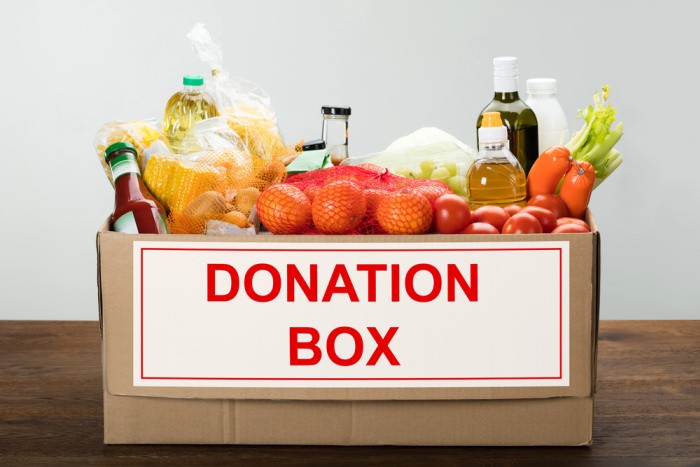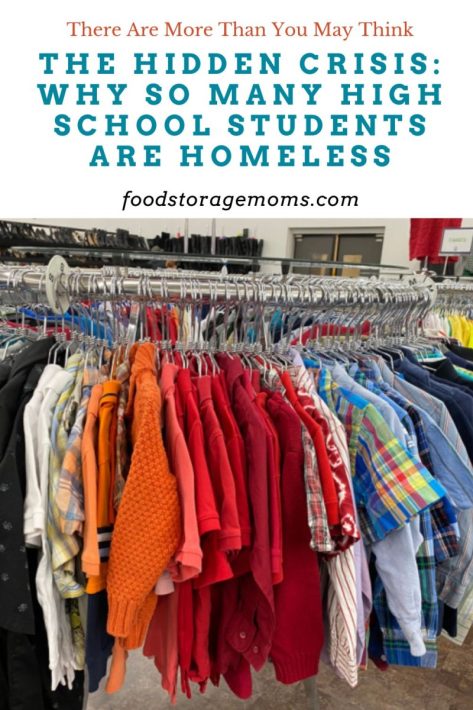
The hidden crisis: Why are so many high school students homeless? When you picture a homeless person, you might imagine an adult sleeping on a park bench or someone holding a cardboard sign on a street corner.
But what if I told you that thousands of homeless people are actually high school students who still take algebra tests, go to football games, and dream about college, even though they don’t know where they’ll sleep tonight?
This is one of America’s quietest tragedies, a hidden crisis unfolding in classrooms across the country.

When Mark and I were living with our daughter while we built our tiny home, my daughter and her husband were asked by the local high school if we could shelter a young student who was no longer welcome at his home. Although the reason was unknown, they immediately took him in, ensuring he had rides to school and activities, food to eat, and a bed to sleep on. He was a senior and just needed some help; he has since gone on to college and pursued his dreams. And no, he was not on drugs.
The area where this school is located is relatively affluent, which might leave you wondering, what? How could this be? Well, it’s everywhere, my friends. I recall a neighbor mentioning at a BBQ in Southern Utah that St. George, Utah, didn’t have a problem with homelessness or food scarcity. Yes, they did. Mark and I served many meals to families in need. Also, child abuse was rampant, dark secrets no one talks about. Homelessness is everywhere.
Mark belongs to a national-based civic club called the National Exchange Club. His particular club is located in a community called Murray, Utah. Murray High School has the Spartans as its mascot. Club members became familiar with a number of students who came to school hungry, wearing worn-out clothes, and needing some basic necessities we all take for granted, like toothpaste and deodorant. The club worked with the high school admin and put together the Spartan Closet. It is a place the kids can go to get treats, clothes, and other items, and do so without embarrassment. Most of the local high schools are trying to do the same kind of thing, with varying success.
Why So Many Teens End Up Homeless
Homelessness among high school students rarely has a single cause. It’s often the result of overlapping crises, family breakdowns, economic hardship, and systemic failures that leave vulnerable teens with nowhere to go.
1. Family Instability and Conflict
Many teens lose their homes because of domestic violence, neglect, or abuse. Others are forced out after coming out as LGBTQ+, leaving them to survive on their own.
Some people leave simply because their home isn’t safe, either emotionally or physically.
2. Poverty and Economic Hardship
Even when families stay together, poverty can push them into homelessness. Job loss, medical bills, or rising rent can quickly destroy a fragile financial situation.
Many families end up “doubled up,” living temporarily with relatives or friends, a situation the government still counts as homelessness under the McKinney-Vento Act.
3. Foster Care and System Failures
Youth who age out of foster care (when they turn 18 years old) without permanent homes often become homeless within months.
With no family, few resources, and limited life skills, these young adults face an uphill battle before they even begin adulthood.
4. The Affordable Housing Crisis
In many cities, housing costs have skyrocketed far beyond what minimum-wage workers or struggling families can afford.
For a student trying to work part-time while attending school, the idea of paying rent is nearly impossible.
5. The Hidden Homeless
Not every homeless teen sleeps under a bridge.
Many couch surf, staying with friends, classmates, or relatives. They might keep their homelessness secret out of shame or fear of being separated from siblings.
These students often go unnoticed and unsupported by schools and social services.
The Impact on Education
Homelessness touches every part of a student’s life.
It’s hard to focus on geometry when you’re hungry or unsure where you’ll sleep. It’s harder still to attend school when you have no clean clothes, no bus fare, or no way to finish homework if you don’t have access to a computer or printer.
Homeless students are:
- More likely to drop out before graduation
- More likely to experience mental health struggles
- Less likely to attend college or gain stable employment
Yet, when given stability and support, these same students can thrive — often showing remarkable resilience and determination.
What We Can Do About It
This crisis may be hidden, but it isn’t hopeless.
Here’s how we can all help:
1. Support the McKinney-Vento Homeless Education Programs
Every U.S. school district is required to have a liaison to help homeless students with transportation, meals, and enrollment, but these programs are often underfunded.
Advocating for them, volunteering, or donating supplies makes a real difference.
2. Increase Awareness
Teachers, parents, and community members can learn to recognize signs of student homelessness, such as chronic absences, frequent moves, or exhaustion, and approach with compassion, not judgment.
3. Support Affordable Housing Initiatives
Stable housing is the foundation of everything else. Supporting local housing nonprofits, shelters, and youth hostels helps create safe spaces for teens in crisis.
4. Offer Practical Help
Gift cards, hygiene kits, blankets, and bus passes can be life-changing for a teen without stable housing. Even small acts of kindness can remind them that they’re not invisible. Most high schools in Utah have Food Pantries and mini Clothing Stores where students can get what they need at no cost.
The Takeaway
Homeless high school students aren’t statistics; they’re young people fighting to hold onto hope in impossible circumstances.
They’re studying for exams in the back of cars, showing up for class after sleeping in shelters, and dreaming of a future that feels just out of reach.
By shedding light on this hidden crisis, we can help ensure that no student has to face the most challenging years of their life alone.
It’s challenging to get a precise count of only high school students who are homeless, because data is usually collected for all K-12 students. But here’s what the numbers show and what we can reasonably infer:
What the data says
- In the 2022-2023 school year, U.S. public schools identified 1,374,537 students as experiencing homelessness. SchoolHouse Connection+1.
- In 2021-2022, the number was 1,205,292 students (about 2.4% of all public school students) National Center for Homeless Education+1.
- In 2020-2021, about 1,099,221 students were identified as homeless. National Center for Homeless Education+1.
- Historically, in 2017-2018, the count peaked around 1.5 million K-12 students. SchoolHouse Connection+1.
Because students in all grades are included, roughly 7%–8% of homeless students are in each grade (kindergarten through about 10th grade), with 11th graders representing about 6% of the homeless student population in some datasets. National Center for Homeless Education.
So, if you take 1.2 to 1.4 million total homeless K-12 students, and assume that high school grades (9–12) make up about 30–35% of that total (4 out of 13 grades), then the number of homeless high school students might be on the order of 350,000 to 500,000 (a rough estimate).
Why is it hard to get an exact figure
- Underreporting: Many homeless youth are “hidden” couch-surfing, staying with friends or relatives, and may not be identified by schools or support systems.
- Data aggregation by grade levels: Most reports lump all K–12 together rather than break out high school segments.
- Variation across districts and states: Some areas have stronger identification systems, others do not.
- Changing definitions: “Homelessness” under the McKinney-Vento Act includes students doubled up, in motels, shelters, etc. Some of these living situations are less visible.
Options or Resources Available
That’s an essential and compassionate topic. Homeless high school students face enormous barriers, but there are programs and options designed to help them stay safe, continue their education, and build stability. Here’s a breakdown of key options and resources available to them:
1. School-Based Support (McKinney-Vento Act)
Every public school district in the U.S. is required by federal law (McKinney-Vento Homeless Assistance Act) to support homeless students.
Services include:
- The right to enroll immediately, even without proof of address, immunizations, or guardianship.
- Free transportation to and from the student’s “school of origin.”
- Access to free meals (no paperwork required).
- A Homeless Liaison at every district to connect students with housing, counseling, and supplies.
Tip: Ask a counselor or principal to contact the district’s McKinney-Vento liaison.
2. Housing and Shelter Options
- Youth Shelters & Drop-In Centers: Many cities have safe shelters for teens (sometimes 16–22) that provide meals, beds, counseling, and help with school.
- Host Homes: Community members volunteer to house students temporarily through organizations like Point Source Youth or Safe Families for Children.
- Transitional Living Programs (TLPs): Long-term housing (up to 18–24 months) for youth aged 16–22, often paired with job training or GED support.
- Family Reunification Programs: Help mediate family conflict and safely reconnect youth with relatives when possible.
3. Basic Needs and Essentials
- Food Banks and Pantries: Most allow walk-ins, no ID required. Schools often have “backpack programs” that send food home for weekends.
- Clothing Closets: Many schools, churches, and community centers provide free clothing, hygiene kits, and school supplies.
- Community Centers/YMCAs: Often have showers, laundry access, and quiet study areas.
4. Financial and Educational Help
- FAFSA (Financial Aid for College): Homeless students (or unaccompanied youth) can apply for aid without parental information.
- Scholarships: Programs like SchoolHouse Connection, Covenant House, and National Center for Homeless Education offer grants for homeless or formerly homeless students.
- Employment Programs: Job Corps, local workforce centers, and nonprofits like Covenant House help with resume skills, internships, and apprenticeships.
5. Mental Health and Counseling Support
Homelessness is traumatic—support is available through:
- School counselors trained under McKinney-Vento.
- Community mental health clinics (often with sliding scale or free options).
- Hotlines:
- National Runaway Safeline: 1-800-786-2929
- Call: 988 Suicide & Crisis Lifeline
- Text “SAFE” and your location to 4HELP (44357) for local shelters and support.
6. Local and National Organizations
- Covenant House: emergency housing and education programs for homeless youth.
- StandUp for Kids: mentoring and outreach for homeless teens.
- National Network for Youth (NN4Y): connects young people to local support programs.
- United Way 211: call or visit 211.org to find any local resource (housing, food, school help, healthcare).
How to Survive in a Homeless Shelter
School Emergency Kits: What You Need to Know
Final Word
No teenager should have to worry about where they’ll sleep at night or how they’ll get to school in the morning. Yet thousands of high school students across the country face homelessness every year. The good news is that help exists—through schools, communities, and caring organizations that believe in their potential. With the proper support and awareness, we can give every student the stability, safety, and opportunity they deserve to build a brighter future. May God bless this world, Linda
Copyright Images: Box Full Of Donated Food Depositphotos_153322528_S,
The post The Hidden Crisis: Why So Many High School Students Are Homeless appeared first on Food Storage Moms.
from Food Storage Moms
No comments:
Post a Comment